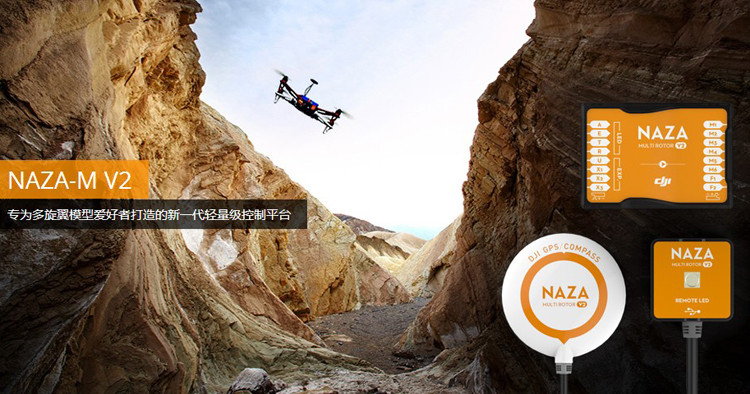DJI drone flight control system-NAZA

Currently commonly used DJI multi-rotor flight control systems are: Naza-M, WooKong-M and A2. Among them, Naza-M is mainly suitable for ordinary users and DIY users, and it is recommended to install on small multi-rotor aircraft; WooKong-M and A2 are mainly suitable for professional users and are suitable for installation on relatively large multi-rotor aircraft.
Naza-M "Naza"
is a new generation of lightweight DJI multi-rotor control platform. It is different from WooKoog-M's application of heavy load and professional aerial photography. While inheriting the excellent flight stability of DJI products, it provides excellent feel and maneuverability. For DIY enthusiasts, the Naza series are relatively cheap and cost-effective.
 It supports nine multi-rotor types
It supports nine multi-rotor types
 Free open ground station
Free open ground station
 Intelligent Orientation Control (IOC)
During normal flight, the forward direction of the aircraft is the nose of the aircraft. After enabling the intelligent direction control, the forward direction of the aircraft has nothing to do with the nose of the aircraft during the flight. When using heading lock, the flight forward direction is the same as the heading of the nose recorded by the master at a certain time.
Intelligent Orientation Control (IOC)
During normal flight, the forward direction of the aircraft is the nose of the aircraft. After enabling the intelligent direction control, the forward direction of the aircraft has nothing to do with the nose of the aircraft during the flight. When using heading lock, the flight forward direction is the same as the heading of the nose recorded by the master at a certain time.
 Home point lock
When using home lock, the forward flight direction is the direction from home point to the aircraft.
Home point lock
When using home lock, the forward flight direction is the direction from home point to the aircraft.
Propeller break protection function
means that when the aircraft accidentally loses a certain propeller power output in the attitude or GPS attitude mode, the aircraft can use the method of sacrificing the control of the yaw axis to continue to maintain the flight level attitude. At this point, the aircraft can continue to be controlled and return safely.
When the control distance between the aircraft and the remote controller is too far or the connection is lost due to signal interference, the system will trigger the runaway protection function. When the GPS signal is good, the automatic return home safe landing function will be triggered automatically. In addition, the function of automatic return to home triggered by the remote control switch is newly added, without entering the fail-safe mode.
Lost control and return home, one key to return home
The above are the characteristics and introduction of the Naza-m series flight controller.
Pixhack V5 PlusFlight Controller for VTOL

airplane autopilot is an advanced autopilot for academic and commercial integrators. Designed by CUAV in collaboration with the PX4 team. Based on the Pixhawk FMU v5 open hardware design, a highly modular board using Pixhawk standard pinouts for its external interface, allowing for carrier board integration. Out of the box pre-installed with PX4 Open Source Autopilot, and fully supported by ArduPilot.
An autopilot is a system used to control the trajectory of an aircraft without constant ‘hands-on’ control by a human operator being required. Autopilots do not replace human operators, but instead they assist them in controlling the aircraft. This allows them to focus on broader aspects of operations such as monitoring the trajectory, weather and systems.[1] The autopilot is often used in conjunction with the autothrottle, when present, which is the analogous system controlling the power delivered by the engines.
airplane autopilot Quick Summary





















